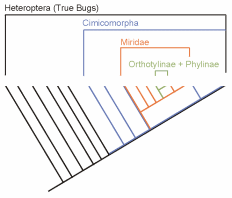Some morphological aspects of the Phylinae
The Phylinae are diagnosed primarily on the structure of male genitalia, which are distinctive in their possession of a sclerotized, rigid, non-inflatable vesica and the phallotheca attached to the posterior wall of the genital capsule rather than to the phallobase as in all other Miridae. Parempodial structure in the group varies from setiform, to weakly fleshy, to fleshy, recurved, and apically divergent. The posterior wall in the female genitalia is simple and unornamented.
Some biological aspects of the Phylinae
In temperate regions of the world members of the group are univoltine and for the most part show strong host specificity. Many phylines are brown or somber in coloration; a few are black, but none are aposematic. At least four lineages are strongly myrmecomorphic.




